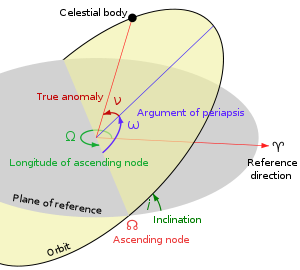- Orbital inclination
-
For the science fiction novella by William Shunn, see Inclination (novella).
Inclination in general is the angle between a reference plane and another plane or axis of direction.
Contents
Orbits
The inclination is one of the six orbital parameters describing the shape and orientation of a celestial orbit. It is the angular distance of the orbital plane from the plane of reference (usually the primary's equator or the ecliptic), normally stated in degrees.[1]
In the Solar System, the inclination of the orbit of a planet is defined as the angle between the plane of the orbit of the planet and the ecliptic — which is the plane containing Earth's orbital path.[2] It could be measured with respect to another plane, such as the Sun's equator or even Jupiter's orbital plane, but the ecliptic is more practical for Earth-bound observers. Most planetary orbits in the Solar System have relatively small inclinations, both in relation to each other and to the Sun's equator. There are notable exceptions in the dwarf planets Pluto and Eris, which have inclinations to the ecliptic of 17 degrees and 44 degrees respectively, and the large asteroid Pallas, which is inclined at 34 degrees.
Inclination Name Inclination
to eclipticInclination
to Sun's equatorInclination
to invariable plane[3]Terrestrials Mercury 7.01° 3.38° 6.34° Venus 3.39° 3.86° 2.19° Earth 0° 7.155° 1.57° Mars 1.85° 5.65° 1.67° Gas giants Jupiter 1.31° 6.09° 0.32° Saturn 2.49° 5.51° 0.93° Uranus 0.77° 6.48° 1.02° Neptune 1.77° 6.43° 0.72° Natural and artificial satellites
The inclination of orbits of natural or artificial satellites is measured relative to the equatorial plane of the body they orbit if they do so close enough. The equatorial plane is the plane perpendicular to the axis of rotation of the central body.
- an inclination of 0 degrees means the orbiting body orbits the planet in its equatorial plane, in the same direction as the planet rotates;
- an inclination greater than -90° and less than 90° is a prograde orbit.
- an inclination greater than 90° and less than 270° is a retrograde orbit.
- an inclination of exactly 90° is a polar orbit, in which the spacecraft passes over the north and south poles of the planet; and
- an inclination of exactly 180° is a retrograde equatorial orbit.
- an inclination of exactly 270° is a polar orbit in the opposite direction to a 90° polar orbit.
For the Moon, measuring its inclination with respect to Earth's equatorial plane leads to a rapidly varying quantity and it makes more sense[clarification needed] to measure it with respect to the ecliptic (i.e. the plane of the orbit that Earth and Moon track together around the Sun), a fairly constant quantity.[citation needed]
Exoplanets and multiple star systems
The inclination of exoplanets or members of multiple stars is the angle of the plane of the orbit relative to the plane perpendicular to the line-of-sight to the object.
- an inclination of 0° is a prograde face-on orbit, meaning the plane of its orbit is parallel to the sky;
- an inclination greater than 0° and less than 90° orbits in the same direction as the rotation of its star;
- an inclination of exactly 90° is an edge-on orbit regardless if the orbit is prograde or retrograde, meaning the plane of its orbit is perpendicular to the sky;
- an inclination greater than 90° and less than 180° orbits in the opposite direction as the rotation of its star; and
- an inclination of 180° is a retrograde face-on orbit, meaning the plane of its orbit is parallel to the sky.
Because the radial velocity method is easier to find planets with more edge-on orbits, most exoplanets would have inclinations between 45° and 135°, even though most exoplanets don't have known inclination. Correspondingly, most exoplanets would have true masses no more than 70% greater than their minimum masses. If the orbit is almost edge-on, then the planet can be seen transiting its star. If the orbit is almost face-on, especially for superjovians detected by radial velocity, then those objects may actually be brown dwarfs or even red dwarfs. One particular example is HD 33636 B, which has true mass 142 MJ, corresponding to an M6V star, while its minimum mass was 9.28 MJ. The inclinations and hence true masses for almost all the exoplanets will eventually be measured by the number of observatories in space, including the Gaia mission, Space Interferometry Mission, and James Webb Space Telescope.[citation needed]
Other meanings
- For planets and other rotating celestial bodies, the angle of the axis of rotation with respect to the normal to plane of the orbit is sometimes also called inclination or axial inclination, but to avoid ambiguity can be called axial tilt or obliquity.[citation needed]
- In geology, the magnetic inclination is the angle made by a compass needle with respect to the horizontal surface of the Earth at a given latitude.[citation needed]
Calculation
In astrodynamics, the inclination i can be computed from the orbital momentum vector
 (or any vector perpendicular to the orbital plane) as
(or any vector perpendicular to the orbital plane) as  , where hz is the z-component of
, where hz is the z-component of  .
.See also
- Altitude (astronomy)
- Axial tilt
- Azimuth
- Beta Angle
- Kepler orbits
- Kozai effect
- Orbital inclination change
References
- ^ Chobotov, Vladimir A. (2002). Orbital Mechanics (3rd ed.). AIAA. pp. 28–30;. ISBN 1563475375.
- ^ McBride, Neil; Bland, Philip A.; Gilmour, Iain (2004). An Introduction to the Solar System. Cambridge University Press. p. 248. ISBN 0521546206.
- ^ "The MeanPlane (Invariable plane) of the Solar System passing through the barycenter". 2009-04-03. http://home.comcast.net/~kpheider/MeanPlane.gif. Retrieved 2009-04-10. (produced with Solex 10 written by Aldo Vitagliano)
Categories:- Celestial mechanics
- Orbits
- Astrodynamics
Wikimedia Foundation. 2010.














